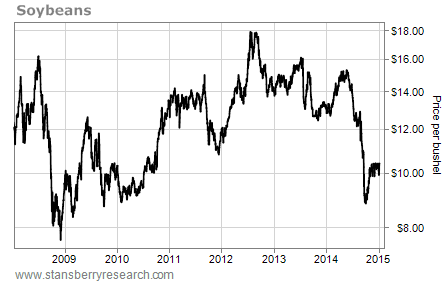You can make a lot of money buying commodities when they’re in “bust” mode.
We told you about one of these opportunities setting up a few months ago. The price of corn was down around 20% for the year. In September, it cost more to grow corn than it was worth in the market.
[ad#Google Adsense 336×280-IA]So many farmers were shifting from growing corn to growing soybeans.
With supply dropping and demand holding steady (and even increasing), we said corn prices would soon boom.
The price of corn is now up 25% since its September 30 bottom.
Now, many contrarian traders are turning their focus to another agriculture commodity – soybeans…
Soybeans are the second-largest crop produced in the U.S. (corn is the first).
And as you can see in the chart below, prices have been on a roller coaster over the past few years.
 Soybean prices are down around 17% over the past year. After recently hitting their lowest level in four years, they’re now back up to near $10.50 a bushel today.
Soybean prices are down around 17% over the past year. After recently hitting their lowest level in four years, they’re now back up to near $10.50 a bushel today.
This has led many contrarian commodity traders to think we’ve seen a bottom… But it’s not time to invest yet. You see, soybean prices are likely headed lower this year.
We recently spoke to Brent Baker, a commodity broker at John P. Stewart & Associates.
In September, Brent told us low corn prices would cause farmers to shift from growing corn to growing soybeans.
We’re seeing that now. The U.S. Department of Agriculture (USDA) forecasts farmers worldwide will produce nearly 11.5 billion bushels of soybeans this crop year (September to August). But we will only consume 10.5 billion bushels over the same period.
And the soybean glut isn’t limited to the U.S. Jack Scoville of the Chicago brokerage PRICE Futures Group says soybean crops will be at or near record levels in Brazil, Argentina, Paraguay, and Bolivia this year.
The USDA’s most recent estimates show worldwide soybean production will increase by 9.6% this year over last year. Worldwide demand is growing, but not as fast. Production will grow two times as fast as demand.
This will cause soybean inventories to rise to their highest level ever. In the U.S. alone, soybean inventories will increase by 320 million bushels. Last year, they fell by nearly 50 million.
The oversupply of soybeans should keep a ceiling on the price in the months ahead and eventually contribute to further price weakness.
Brent says his company’s analysis shows soybeans could drop to $8.50 per bushel by November (assuming no major weather issues). That’s around 19% below today’s soybean prices. You see, the last time we saw market conditions like today was in 1989. Soybean prices fell as much as $2.00 per bushel from January to November that year.
Eventually, things will get better in the soybean market. When prices fall enough, farmers will switch to growing another commodity… supply will fall… and prices will rise.
But we’re not there yet. Prices could go much lower in the months ahead. We’re waiting until soybeans fall to at least $8.50 per bushel before we get interested.
Good investing,
Brian Weepie
[ad#stansberry-ps]
Source: Growth Stock Wire

